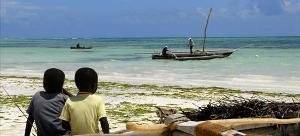Tanzania: Sea-Level Rise and Impacts in Africa, 2000 to 2100. Application of the DIVA model to Africa.


The coast in Tanga, Tanzania. Image: ©steppestravel.co.uk
Impacts of sea-level rise in Tanzania
Tanzania has a coastline of 3,461km and consists of mangrove forests and swamps, coral reefs, cliffs, sand & mudflats, and tidal marshes. Approximately 25% of the total population lives along the coastline (Torell et al., 2004). The coastal zone varies from 20km to 70km in width gradually rising to a plateau (Argawala et al., 2003). Dar es Salaam and the islands of Zanzibar have the highest population densities that might be threatened due to climate change and sea-level rise Agriculture comprised over 45% of the nation’s GDP in 2000 (World Bank, 2002) and is the most important sector of Tanzanian economy on which 80% of the population depend (Argawala et al., 2003). The major crops are maize, coffee and cotton.
Tanzania has a coastline of 3,461km and consists of mangrove forests and swamps, coral reefs, cliffs, sand & mudflats, and tidal marshes. Approximately 25% of the total population lives along the coastline (Torell et al., 2004). The coastal zone varies from 20km to 70km in width gradually rising to a plateau (Argawala et al., 2003). Dar es Salaam and the islands of Zanzibar have the highest population densities that might be threatened due to climate change and sea-level rise Agriculture comprised over 45% of the nation’s GDP in 2000 (World Bank, 2002) and is the most important sector of Tanzanian economy on which 80% of the population depend (Argawala et al., 2003). The major crops are maize, coffee and cotton.
Very little protection has been made around Dar es Salaam. Tourist facilities – hotels and roads are partly protected from erosion by groynes and a sea-wall. The cost for building sea walls to protect important vulnerable areas of the city against a 1-m rise in sea level is estimated as US$ 337 million. it is also predicted that on average about 400m landward retreat would occur in Dar es Salaam under a 1-m sea-level rise, and a total of 247km2 land could be lost (Mwaipopo, 2000). According to the Initial National Communication of Tanzania (2003), structures costing US$82 millions in the vulnerable region of Dar es Salaam would also be at risk for a 1-m rise in sea level. However, while the country appears to be one of the African countries most at risk (see the DIVA analysis later), the literature about impacts of sea-level rise in Tanzania is very limited, indicating the need for further work.
Suggested citation
Brown, S., Kebede, A.S., and Nicholls, R.J. (2011). Sea-Level Rise and Impacts in Africa, 2000 to 2100. University of Southampton, UK, 215pp
(0) Comments
There is no content